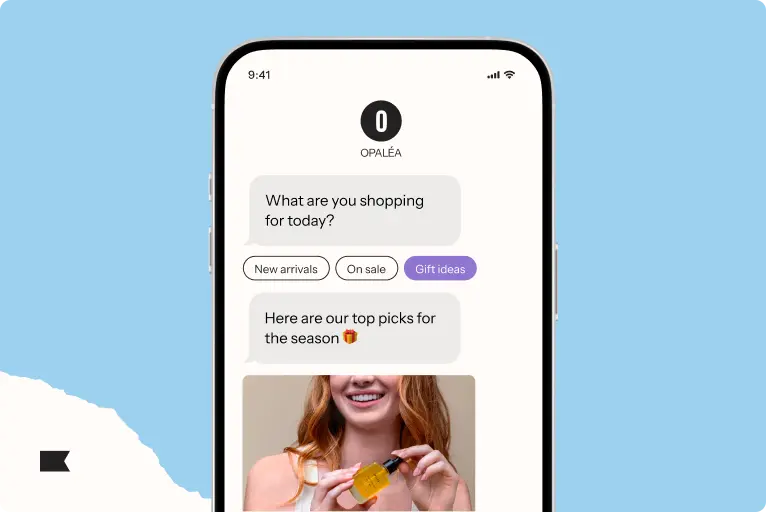6 proven SMS tactics to boost your program and increase profits

The benefits of investing in your SMS marketing program are getting clearer every year.
In a recent survey of nearly 9K people, Klaviyo and recurring payments platform Recharge found that:
- Text messages do indeed drive purchases. Nearly 75% of consumers make a purchase after getting a text from a brand.
- SMS can speed up time to purchase. 65% of people buy something more quickly than they originally intended to after getting a text from a brand.
- People who buy from text messages tend to buy more often. 86% of respondents made 2+ purchases from an SMS message in the last year, up from 55% in 2022. Nearly a third of that group had made 4+ in the last year.
These numbers are pretty hard to argue with. But plenty of brands are understandably shy, hanging out in the starting blocks or stalling out after an initial run at it.
If your SMS marketing program isn’t going as well as you’d hoped, you’re not alone. It’s a delicate channel, and still relatively new.
At Zettler Digital, I partner with brands to accelerate their ecommerce growth through marketing channels like SMS. I see all too often how easy it is even for seasoned marketers to make mistakes when getting their SMS program off the ground.
Here are 6 fixes that I’ve seen help brands get a better ROI.
1. Pay attention to what you’re spending on
So many brands get into trouble with SMS marketing because their costs balloon quickly. But there are ways to spend efficiently. If you’re skeptical about SMS and want to make sure it’s worth the spend, consider following these guidelines:
- Use images sparingly—if at all. While images can grab attention, they make your texts more expensive to send. If the image or gif elevates the message, it’s worth A/B testing to make sure it’s worth the cost. But brands that are just starting an SMS program may consider leaving them out—or using them sparingly.
- Be careful about emoji use. Emojis aren’t always worth the SMS credits they cost—especially given that, when you use them, they reduce character limit from 160 to 70. I’ve seen brands run up 6-figure bills in a single month with SMS from sending too many messages a day and including emojis in that content—that alone can make SMS an unprofitable channel when you consider the impact on character counts per message credit.
- Stick to 160 characters or below—at least while you’re launching your program. Your subscribers don’t need—or want—lengthy messages. Share what you need them to know, but keep it concise and actionable. It’s not worth the extra word or two to send a message with 175 characters when that alone will double the cost.
Of course, there are a few caveats. Mindy Regnell, head of market intelligence at Klaviyo, stresses the importance of staying compliant, regardless of the length of your content: “Make sure you include your company’s name at the start of every text and the opt-out message at the end.”
Make sure you include your company’s name at the start of every text and the opt-out message at the end.
2. Have a theory? A/B test it
You may have a longer message or one with images or emojis that’s worth the price. Or you may find that subscribers are more likely to convert when an abandoned check-out SMS message includes dynamic image content vs. text only.
Having data to back that up, though, is important. This is why it’s crucial to A/B test to get clarity on what is best for your audience.
“A/B testing is especially valuable in 3 scenarios,” says Savannah Mazola, implementation consultant at Klaviyo.
- When you’re launching your SMS program
- When you’re optimizing your existing SMS strategy
- Leading up to a season when you’ll be increasing your send volume, like Black Friday Cyber Monday
Here are some aspects of your SMS marketing to A/B test:
- Message length
- MMS vs. SMS
- Emojis vs. no emojis
- Send times
Playing a guessing game is just not necessary when you have A/B testing tools at your disposal. Make sure to implement this practice in your SMS program early on.
A/B testing is especially valuable in 3 scenarios: when you’re launching your SMS program, when you’re optimizing your existing SMS strategy, and leading up to a season when you’ll be increasing send volume, like BFCM.
3. Segment, segment, segment
Similar to email, your inclusions (who you send to) and exclusions (who you leave out) are vital to SMS success.
“Segmentation allows you to create a more personalized sending strategy that often leads to increased engagement—and decreased unsubscribe rates,” says Mazola.
Here are some guidelines around segmenting for SMS:
Make sure your audience is properly segmented and that you’re sending personalized texts. It’s also a good idea to prioritize content for those who want to receive your SMS messaging and are likely to engage.
Just like email, sending indiscriminately to your entire list will only hurt SMS performance. Customers subscribe for different reasons—some want transactional messaging, others are interested in a particular product, etc.
With email, it makes sense to occasionally send a certain campaign to your entire list—huge promotions like Black Friday, for example. But sending to your entire SMS list can be very expensive. Segmenting your SMS list will set you up to send personalized messaging, keeping your content relevant and your costs down.
This ensures you won’t annoy anyone who’s recently bought.
If a subscriber isn’t receiving your text marketing, don’t waste message credits or harm your sender reputation by sending to them.
SMS error segment tip: Not excluding profiles with SMS errors from receiving campaigns can be harmful for performance. But you should also prevent those same users from receiving flow content. Create a flow that applies a profile property to user profiles when they’re identified in an SMS error segment. Use that profile property to filter them out of flow messaging.
4. Start with transactional SMS and automated flows
When I’m working with a brand to get their SMS program off the ground, I recommend they get started with the basics: transactional messaging like shipping updates, and automated flows like a welcome series, abandoned check-out, and browse abandonment.
These types of texts aren’t likely to annoy anyone, and remember: these automations don’t need to be entirely via SMS—you can also incorporate SMS touchpoints into your existing email flows.
5. Build hype with sales—but make sure your communication aligns with your calendar
A successful tactic I see across the brands we work with is building excitement for an upcoming sale exclusively through SMS.
Start by communicating across email, organic social, paid marketing, and on-site to drive awareness of an upcoming promotion, letting customers know they will be able to access it only via SMS.
In the day or two prior to that sale, launch a teaser message across the same channels that reveals some information about that upcoming sale and when it will launch. Make sure to include a prompt to sign up for the list.
When the day comes, give a few hours of exclusivity to running that promotion via SMS before opening up to other channels.
Zettler Digital has seen strong revenue performance across many client accounts where we’ve followed this process. It becomes a good way to get a quick measurement of how impactful SMS communications can be.
The important caveat here is to make sure that you don’t overdo this. Only build hype like this when you actually have an exciting sale or product launch. One of the fastest ways to get people to unsubscribe from SMS is to constantly bombard them with repetitive messaging about an exciting sale or product drop that isn’t actually very notable at all.
Make sure your copy aligns with what you have to offer—in other words, don’t promote deals and try to hype up your subscribers every single day. This kind of mistake is rampant, and it’s never worth the money spent to even send the promotional messaging.
6. Consolidate your email and SMS on one platform
“When you optimize for a single channel like SMS using a point solution, you may find your team’s strategy focusing only on that channel, whereas using an all-in-one platform like Klaviyo helps optimize across channels,” says Regnell.
When you optimize for a single channel like SMS using a point solution, you may find your team’s strategy focusing on on that channel, whereas using an all-in-one platform like Klaviyo helps optimize across channels.
It’s true: running your email through one platform and your SMS through another can lead to disorganization, clouding your understanding of who’s receiving what messages and when they’re getting them. Not only that, but in 100% of the cases I’ve looked at, brands that have their email and SMS on different platforms are overpaying.
So, like SMS marketing itself, consolidating your channels under one platform is very much worth the time and effort.
Related content
- The crawl, walk, run approach to launching your SMS marketing strategy
- SMS marketing best practices: 13 expert-tested tips for boosting engagement now
- SMS for VIPs

Related content

Looking for the best SMS marketing tools? See the top 3 platforms for 2026 and learn how to choose the right one for segmentation, automation, and two-way messaging

Marketers are right to be cautious right now. The Texas settlement has sparked more questions than clarity—but that’s exactly why taking a compliance-first approach still matters.

Google’s RCS Roadshow and Klaviyo are shaping the future of mobile marketing with AI-powered personalization and trusted, interactive messaging.